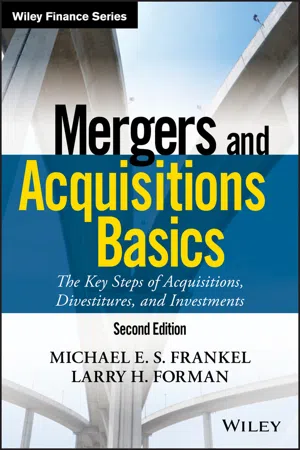
Mergers and Acquisitions Basics
The Key Steps of Acquisitions, Divestitures, and Investments
- English
- ePUB (mobile friendly)
- Available on iOS & Android
Mergers and Acquisitions Basics
The Key Steps of Acquisitions, Divestitures, and Investments
About this book
The essential executive M&A primer, with practical tools and expert insight
Mergers and Acquisitions Basics provides complete guidance on the M&A process, with in-depth analysis, expert insight, and practical tools for success. This new second edition has been updated to reflect the current M&A landscape, giving busy executives the ideal resource for navigating each step in the process. Veteran executives relate guidelines, lessons learned, and mistakes to avoid as they explain how M&As work, identify the major players, and describe the roles involved in a successful transaction. Both buyer and seller must consider a broad range of factors, and this essential guide provides checklists, forms, sample reports, and presentations to help you avoid surprises and ensure your organization's full preparation for the deal. Equity investments, valuation, negotiation, integration, legal aspects, and more are explained in detail to provide a foundational primer for anyone seeking to clarify their role in the process.
Mergers and acquisitions are becoming ever more critical to the growth of large and mid-sized companies. This book balances depth and breadth to provide a one-stop guide to maximizing the financial and operational value of the deal.
- Identify key drivers of purchase or sale
- Understand major roles, processes, and practices
- Avoid valuation detractors and negotiate effectively
- Overcome common challenges to successful integration
Effective M&As are highly strategic, solidly structured, and beneficial on both sides. It's a complex process with many variables, many roles, and many potential pitfalls, but navigating the deal successfully can mean the difference between growth and stagnation. Mergers and Acquisitions Basics is the comprehensive resource every executive needs to understand the ins-and-outs of strategic transactions.
Frequently asked questions
- Essential is ideal for learners and professionals who enjoy exploring a wide range of subjects. Access the Essential Library with 800,000+ trusted titles and best-sellers across business, personal growth, and the humanities. Includes unlimited reading time and Standard Read Aloud voice.
- Complete: Perfect for advanced learners and researchers needing full, unrestricted access. Unlock 1.4M+ books across hundreds of subjects, including academic and specialized titles. The Complete Plan also includes advanced features like Premium Read Aloud and Research Assistant.
Please note we cannot support devices running on iOS 13 and Android 7 or earlier. Learn more about using the app.
Information
CHAPTER 1
Introduction




Table of contents
- Cover
- Title Page
- Copyright
- Table of Contents
- Preface
- Acknowledgments
- Chapter 1: Introduction
- Chapter 2: The Players
- Chapter 3: Decision to Buy or Sell
- Chapter 4: Buyer's Preparation for the Deal
- Chapter 5: Seller's Preparation for the Deal
- Chapter 6: Deal Process
- Chapter 7: Due Diligence
- Chapter 8: Valuation
- Chapter 9: Integration Planning
- Chapter 10: Financing Issues
- Chapter 11: Closing the Deal and After
- Appendix A: Standard Form Deliverables During a Strategic Transaction Example
- Appendix B
- Appendix C: Standard Deal Process Checklist Example
- Appendix D: Standard Approval Process Example
- Appendix E: Approval of a Strategic Transaction: Key Topics in Presentation
- Appendix F: Generic Valuation Exercise
- Appendix G: Generic Acquisition Term Sheet for Acquisition by Public Buyer of Privately Held Target
- Appendix H: Generic Investment Term Sheet for Project “Moon”
- Appendix I: Notable Transaction Issues by Country/Territory
- Index
- End User License Agreement